Struggling chip giant Intel is reportedly preparing to slash up to 20% of its global workforce next month — despite the company receiving more than $2 billion in federal funding under former President Biden signature CHIPS Act.
The scale of the layoffs, amounting to around 10,000 workers, was disclosed in an internal email viewed by The Oregonian/OregonLive and confirmed by four Intel employees who spoke to the online news outlet.
“These are difficult actions but essential to meet our affordability challenges and current financial position of the company. It drives pain to every individual,” Naga Chandrasekaran, Intel’s vice president of manufacturing, reportedly wrote in the memo sent to employees on Saturday.
The anticipated reductions are scheduled to begin in weeks and will reportedly affect Intel Foundry, the company’s internal manufacturing division that specializes in producing semiconductors for external customers.
The unit includes a wide spectrum of jobs — from factory technicians to engineers and researchers who design future generations of chips.
Intel was awarded $7.9 billion in federal subsidies last year to support US-based semiconductor manufacturing under the CHIPS Act. The company received $2.2 billion before the remainder was frozen prending a review by the newly-elected Trump administration.
The looming cuts come on top of the 15,000 jobs across its global operations last year — after Intel was awarded the CHIPS Act funds — amid declining demand for PCs and servers and setbacks in developing high-end chips for artificial intelligence applications.
The company has already postponed the opening of its $10 billion Ohio factory until 2030, citing insufficient demand.
Intel shares have dropped nearly 30% over the past 12 months, trading at around $21.50 on Wednesday.
It ousted CEO Pat Gelsinger in March and brought in semiconductor veteran Lip-Bu Tan, who has emphasized streamlining operations, cutting bureaucracy and accelerating innovation.
“While I’m sure tariffs have some impact on Intel’s layoffs, this is actually pretty simple — these layoffs are largely due to the financial challenges Intel is facing in terms of declining revenues,” Matt Kimball, principal analyst at Moor Insights & Strategy, told tech industry publication Network World.
Intel first disclosed its intent to reduce headcount in April, but had not specified the depth of the layoffs until now.
Chandrasekaran indicated to The Oregonian/OregonLive that the cuts would not involve voluntary buyouts this time. Instead, Intel will make decisions based on performance evaluations, strategic priorities, and operational needs.
“These reductions will be based on a combination of portfolio changes, level and position elimination, skill assessment for remaining positions, and some hard decisions around our project investments,” he wrote.
“We are also taking into consideration factory operations impact.”
The Post has sought comment from Intel.
The factory workforce in Oregon may be especially hard-hit. Intel is the state’s largest private employer, with 20,000 workers. The company also operates major manufacturing facilities in Arizona, New Mexico, Israel, Ireland and Malaysia.
Oregon granted Intel $115 million in state incentives, which may be clawed back if the company fails to meet job creation or tax revenue targets tied to a planned expansion of its D1X facility in Hillsboro.
Intel declined to comment to The Oregonian/OregonLive on Chandrasekaran’s memo specifically but said the company remains focused on handling the transition respectfully.
“We will treat people with care and respect as we complete this important work,” the company stated.
“Removing organizational complexity and empowering our engineers will enable us to better serve the needs of our customers and strengthen our execution.”
Intel does not disclose exactly how many of its employees work in factory or manufacturing roles, but estimates can be drawn from its overall workforce and known operations.
As of the end of 2024, the company reported having 109,000 employees globally. A significant share of those workers are part of Intel Foundry.
Intel’s largest manufacturing hub is located in Oregon, where it employs approximately 20,000 people. However, not all of those are directly involved in factory work. The company also operates major manufacturing facilities in Arizona, New Mexico, Israel, Ireland and Malaysia.


